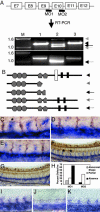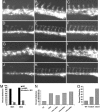roundabout4 is essential for angiogenesis in vivo
- PMID: 15849270
- PMCID: PMC1088354
- DOI: 10.1073/pnas.0408318102
roundabout4 is essential for angiogenesis in vivo
Abstract
Stereotypical patterns of vascular and neuronal networks suggest that specific genetic programs tightly control path determination and, consequently, angiogenesis and axon-guidance mechanisms. Our study focuses on one member of the roundabout family of receptors, which traditionally mediate repulsion from the midline. Here, we characterize a fourth member of this family, roundabout4 (robo4), which is the predominant roundabout (robo) that is expressed in embryonic zebrafish vasculature. Gene knockdown and overexpression approaches show that robo4 is essential for coordinated symmetric and directed sprouting of intersomitic vessels and provide mechanistic insights into this process. Also, human robo4 gene functionally compensates for loss of robo4 gene function, suggesting evolutionary conservation. This article reports an endothelial-specific function for a robo gene in vertebrates in vivo.
Figures




References
-
- Mukouyama, Y. S., Shin, D., Britsch, S., Taniguchi, M. & Anderson, D. J. (2002) Cell 109, 693-705. - PubMed
-
- Neufeld, G., Cohen, T., Shraga, N., Lange, T., Kessler, O. & Herzog, Y. (2002) Trends Cardiovasc. Med. 12, 13-19. - PubMed
-
- Gale, N. W. & Yancopoulos, G. D. (1999) Genes Dev. 13, 1055-1066. - PubMed
-
- Fiore, R. & Puschel, A. W. (2003) Front. Biosci. 8, S484-S499. - PubMed
-
- Brose, K., Bland, K. S., Wang, K. H., Arnott, D., Henzel, W., Goodman, C. S., Tessier-Lavigne, M. & Kidd, T. (1999) Cell 96, 795-806. - PubMed
Publication types
MeSH terms
Substances
Grants and funding
LinkOut - more resources
Full Text Sources
Other Literature Sources
Molecular Biology Databases

